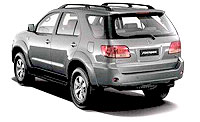
The arrival of the Toyota Fortuner in India has stirred up a frenzy like no other Toyota before it. It’s already received 2,000 confirmed bookings. But does the Fortuner live up to its perceived greatness? Has it really been worth the wait?
 Stationed next to the Endeavour, the Fortuner is taller and more broad-shouldered. Its chest-level bonnet is a towering presence. The huge scoop on the bonnet that feeds air to the air-to-air intercooler, the skid plate that swoops into the bumper and the terrific-looking headlights which sync into the grille command respect.
Stationed next to the Endeavour, the Fortuner is taller and more broad-shouldered. Its chest-level bonnet is a towering presence. The huge scoop on the bonnet that feeds air to the air-to-air intercooler, the skid plate that swoops into the bumper and the terrific-looking headlights which sync into the grille command respect.
The massive wheel arches, filled by huge Dunlop Mud and Snow tyres, a high waistline, and a footboard to step up into the car goes to show that this Sports Utility Vehicle (SUV) means serious business. The high bumper line, which shows off the massive clearance, bears testament to the Fortuner’s off-road ability. The spare wheel on this car is mounted under the boot, unlike the generic spare wheel-sporting tailgates of traditional SUVs.
|
Vital Stats |
| Price: Rs 18.45 lakh (ex-showroom, Delhi) Weight: 1955 kg Ground clearance: 221 mm Fuel tank capacity: 65 litres Engine layout: 4 cyls in-line, direct-injection, turbo diesel Displacement: 2982 cc Power: 171 bhp at 3600 rpm Torque: 35 kgm at 1400-3400 rpm Power to weight: 87.4 bhp per tonne Gearbox: 5-speed manual Wheels: 265/65 DunlopAT20 tubeless Front suspension: Double wishbone Rear suspension: 4-link with coil springs Brakes: Front – ventilated disc; Rear – drums |
A standard-fit five-speed manual gearbox delivers drive to all four wheels all the time. There’s a dedicated low-range transfer case, the differentials can be locked, and low-range gears selected via a smaller lever next to the main gear lever. The Fortuner’s 1,955 kg kerb weight is beautifully balanced. Ground clearance is a towering 221 mm with disc brakes up front and drums at the rear.
Toyota Fortuner: Interiors
Once in the driver’s seat, the ‘high-roller’ feeling you get is fantastic. The seats are supportive, making it easy to get comfortable behind the wheel — the seats adjust manually for height and the steering for rake.
The quality of the plastics, switchgear and overall finish are top-notch. Equipment-wise, two airbags, ABS, 17-inch alloy wheels, a six-CD changer, climate control, remote locking and leather seats are standard issue.
We loved the little cubbyholes under the air-conditioner vents and the big box between the front seats. The middle row makes enough room for six-footers to sit comfortably and seats offer good thigh support and adequate cushioning.
The Toyota Fortuner gets a seven-seat layout, with the third row occupying most of the available boot space. Getting into the last row involves a two-step operation including getting the middle row out of the way. The second-row seats can be moved forwards or backwards on runners, meaning that legroom can be sufficiently divided among rear occupants. On folding the seats (the last row splits 50:50) you get a very useable 1,000 litres of storage space.
Toyota Fortuner: Performance
It took the Fortuner just 12.7 seconds to reach 100 kph, which is quite stunning for a vehicle that weighs nearly two tonnes. There’s a gentle and consistent surge as the turbo starts to tug at 1,500 rpm, and there’s power all the way to 4,000 rpm.
The gear ratios are well matched to the engine’s torque and the wide powerband minimises the need for gearshifts. Aided by the turbocharger, Toyota’s second-generation 2,982 cc engine makes a claimed 168 brake horse power (bhp) at 3,600 rpm. This motor has a four-valve, twin-cam head and three injections per cycle.
The SUV’s gearshift is very much like the Innova’s with its wide gate and long throws. The transfer case ‘high-low’ is also operated with a traditional lever which sits on the outside of the gear lever. There’s even a centre differential lock which splits torque between the front and rear axles.
At high speeds, the Fortuner’s big wheels and the suspension humble dicey roads into submission. The SUV lolls around in corners, rolls quite a bit and though there is plenty of grip from the four-wheel-drive system, it’s rather tiring to hustle its 1,955 kg. The car rolls to a complete stand-still in a respectable 28 metres, but there’s serious brake fade after just a few hard stops.
The low-stressed D4-D engine returned 9.3 km per litre in the city and 12.9 kpl on the highway, impressive figures for a car its size and weight.
© HT Media